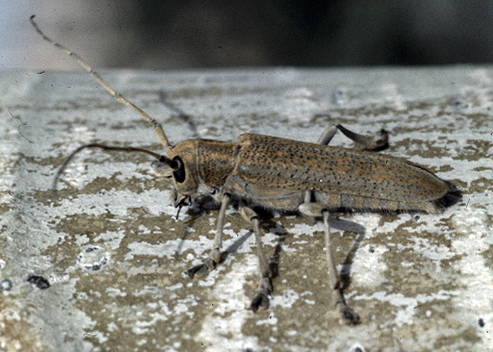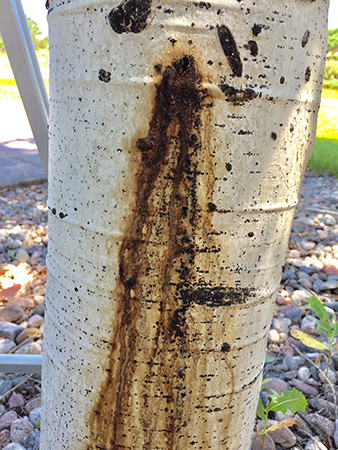Integrated Pest Management
Poplar Borer
 Poplar borer adult. (Whitney Cranshaw, Colorado State University, Bugwood.org)
Poplar borer adult. (Whitney Cranshaw, Colorado State University, Bugwood.org)
 Poplar borer life stages. (James Solomon, USDA Forest Service, Bugwood.org)
Poplar borer life stages. (James Solomon, USDA Forest Service, Bugwood.org)
 Poplar borer gallery hole oozing. (Utah State University)
Poplar borer gallery hole oozing. (Utah State University)
HOSTS
- Aspens
- Poplars
- Willows
DESCRIPTION
During egg-laying, females target trees that are older, under stress, or growing in full sun. Damage occurs mainly on the trunk and larger branches. While branches as small as 1.5 inches in diameter may be attacked, larval feeding is mostly found on limbs or trunks with a diameter of 3 inches or more.
BIOLOGY
Adults are 1- to 2-inch-long beetles with antennae that are about as long as the body. They are gray-blue with fine brown dots overlaying a faint yellow pattern on the wing covers. Females chew slits into the bark and lay one to three eggs within each slit. The larvae are legless, elongate, cylindrical, and yellow-white in color. Their full-grown length is about 1.5 inches. Pupae are usually found near the entrance of frass plugged galleries.
SYMPTOMS
- Oozing sap mixed with fine frass
- Rust colored stains on bark
- Large amounts of course frass at tunnel entrances
GENERAL MANAGEMENT
Natural enemies include woodpeckers, parasitic wasps, and nematodes. Woodpeckers may consume up to 65% of larvae in some regions. Climate and sap flow of individual trees also affect larvae mortality.
INSECTICIDES
Insecticides currently labeled for borer control on poplars include products that contain a pyrethroid or carbaryl. Systemic insecticides, such as acephate or neonicotinoids, do not provide satisfactory control of larvae.
For maximum protection, apply the first treatment about June 1 and a second treatment on July 1. Applications should be most thorough on the bark of existing attacked areas, if any, and the trunk and large branches.

